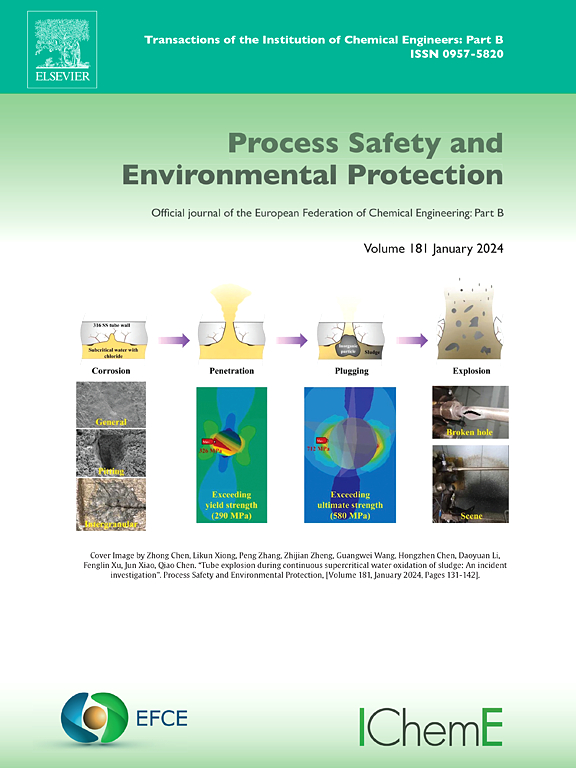用机器学习预测建筑物的空间声衰减:对火灾报警器放置的影响
IF 6.9
2区 环境科学与生态学
Q1 ENGINEERING, CHEMICAL
引用次数: 0
摘要
在紧急情况下,可听、可理解的火灾警报器在确保乘员安全方面起着至关重要的作用。尽管存在各种实验和理论方法来测量和预测报警声级,但这些方法的可变性和局限性,特别是在复杂布局中,仍未得到充分探索。基于已建立的消防工程研究和来自过程安全的先进报警管理概念,本研究通过比较现场测量、基于计算的估计和机器学习预测来评估住宅单元内火灾报警器放置的有效性。研究结果表明,敞开的门比关闭的门产生更高的声音水平,而基于走廊的警报器通常无法达到唤醒睡眠者所需的75dba阈值。此外,已建立的计算方法显示平均错误率约为9 %,特别是在几何复杂或声学可变的设置。相比之下,机器学习模型的错误率明显较低,约为2% %,这突显了它比传统公式更有效地整合距离、分区和声衰减等不确定性因素的潜力。从风险管理的角度来看,这些结果突出了数据驱动的、基于风险的警报设计的价值,与过程工业中看到的混合警报建模方法相一致。该研究的结论是,在每个住宅单元内安装火灾报警器,再加上在睡眠区域安装相互连接的探测仪,可以显著提高居民的警觉性和住宅建筑系统的可靠性。本文章由计算机程序翻译,如有差异,请以英文原文为准。
Predicting spatial sound attenuation in buildings with machine learning: Implications for fire alarm placement
Audible and intelligible fire alarms play a critical role in ensuring occupant safety in emergencies. Although various experimental and theoretical methods exist to measure and predict alarm sound levels, the variability and limitations of these methods, especially in complex layouts, remain underexplored. Building on both established fire engineering research and advanced alarm management concepts from process safety, this study evaluates the effectiveness of fire alarm placement within residential units by comparing in situ measurements, calculation-based estimates, and machine learning predictions. The findings show that open doors result in higher sound levels than closed doors, and corridor-based alarms typically fail to meet the recommended 75 dBA threshold needed to awaken sleeping occupants. Moreover, established calculation methods show an average error rate of about 9 %, especially in geometrically complex or acoustically variable settings. By contrast, the machine learning model achieves a notably lower error rate at around 2 % underscoring its potential to integrate uncertainty factors such as distance, partitions, and acoustic attenuation more effectively than traditional formulas. From a risk management perspective, these results highlight the value of data-driven, risk-based alarm design, aligning with hybrid alarm modeling approaches seen in process industries. The study concludes that installing fire alarms within each dwelling unit, coupled with interconnected sounders in sleeping areas, significantly enhances occupant alertness and system reliability in residential buildings.
求助全文
通过发布文献求助,成功后即可免费获取论文全文。
去求助
来源期刊

Process Safety and Environmental Protection
环境科学-工程:化工
CiteScore
11.40
自引率
15.40%
发文量
929
审稿时长
8.0 months
期刊介绍:
The Process Safety and Environmental Protection (PSEP) journal is a leading international publication that focuses on the publication of high-quality, original research papers in the field of engineering, specifically those related to the safety of industrial processes and environmental protection. The journal encourages submissions that present new developments in safety and environmental aspects, particularly those that show how research findings can be applied in process engineering design and practice.
PSEP is particularly interested in research that brings fresh perspectives to established engineering principles, identifies unsolved problems, or suggests directions for future research. The journal also values contributions that push the boundaries of traditional engineering and welcomes multidisciplinary papers.
PSEP's articles are abstracted and indexed by a range of databases and services, which helps to ensure that the journal's research is accessible and recognized in the academic and professional communities. These databases include ANTE, Chemical Abstracts, Chemical Hazards in Industry, Current Contents, Elsevier Engineering Information database, Pascal Francis, Web of Science, Scopus, Engineering Information Database EnCompass LIT (Elsevier), and INSPEC. This wide coverage facilitates the dissemination of the journal's content to a global audience interested in process safety and environmental engineering.
 求助内容:
求助内容: 应助结果提醒方式:
应助结果提醒方式:


